Synthesis, characterization, and design of molecular materials, especially molecular conductors (including superconductors), have been undertaken. Molecular conductors exhibit a variety of physical properties which can be systematically understood on the basis of "simple" and "clear" electronic structures. From a chemical point of view, the most fascinating character of the molecular conductor is its "designability", that is, we can finely control solid state properties with chemical modifications of the molecule. The newly synthesized materials are characterized by the X-ray diffraction method and physical measurements (electrical conductivity...etc.). The electronic structure is investigated by the simple band structure calculation. All these results are devoted to the design of new molecular materials.
- Development of molecular conductors based on novel metal dithiolene complexes
- Field effect measurement of molecular conductors on substrates and organic Mott-FET
- Massless Dirac Fermions in Organic Conductors
- Photo-induced phase transition in BEDT-TTF salts
- Control of the electronic states in molecular conductors by use of dynamical external fields
- Monte Carlo study on dielectric properties of hydrogen-bonded molecular crystal
(2) High pressure electrical properties of a single component molecular crystal [Ni(ddt)2]
(3) Multiple band molecular conductors based on Pt(dmit)2 complex
(4) Dielectric constant of Pd(dmit)2 salts
(5) Critical exponents of the Mott transition in EtMe3P[Pd(dmit)2]2
(6) First-principles study on the electronic structure of (Cation)[Pd(dmit)2]2
(7) Development of novel bi-layer Ni(dmit)2 anion radical salts
(8) Anomalous Hall effect in (Me-3,5-DIP)[Ni(dmit)2]2
(9) Development of novel molecular magnetic conductors with Ferrocene-TTF hybridized organic donors
(2) Development of monolayer Mott FET utilizing self-assembly process
- Development of molecular conductors based on novel metal dithiolene complexes
- Field effect measurement of molecular conductors on substrates and organic Mott-FET
- Massless Dirac Fermions in organic conductors
- Photo-induced phase transition in BEDT-TTF salts
- Control of the electronic states in molecular conductors by use of dynamical external fields
- Monte Carlo study on dielectric properties of hydrogen-bonded molecular crystal
Metal dithiolene complexes have provided a variety of molecular conductors. Among them, most of anion radical salts of Pd(dmit)2 (Scheme) belong to a strongly correlated two-dimensional system with a quasi triangular lattice of [Pd(dmit)2]2- dimers. The conduction band originates from HOMO, which is associated with the strong dimerization and a small HOMO-LUMO energy splitting. Their electronic state is associated with various degrees of freedom (including charge, spin, orbital, and lattice) and can be tuned by pressure and counter cations.
(1) Quantum spin liquid state in a molecular conductor β'-Pd(dmit)2 mixed salts
Assign: Kato, Cui, Ueda, M. Yamashita; S. Yamashita, H. Yamamoto, A. Tajima, N. Tajima, Ishii, Fukunaga, Kubo
The interplay between frustration and strong electronic correlations in quasi-two-dimensional molecular conductors with triangular lattices generates a wide range of exotic phases including spin liquid, valence bond solid, charge order, and unconventional superconductivity. The series of anion radical salts β'-X[Pd(dmit)2]2 (X: closed-shell monovalent cations EtxMe4-xZ+, where x = 0-2 and Z = P, As, Sb) represents an important class of model systems for investigating quantum frustration. At ambient pressure, all these salts are Mott insulators and belong to a spin-1/2 system with antiferromagnetic Heisenberg interactions. The Pd(dmit)2 molecules in the β'-type crystal structure are strongly dimerized. Interdimer transfer integrals between the frontier molecular orbitals indicate that the dimer units form a quasi-triangular lattice within the anion layer and that spin frustration occurs. The ground states of these salts vary drastically depending on the choice of cation. The Me4Sb salt exhibits antiferromagnetic long-range order (AFLO). The Et2Me2Sb salt undergoes a charge order (CO) transition. The EtMe3Sb salt exhibits no indication of spin ordering/freezing down to 19.4 mK (less than 0.01% of the exchange coupling J) and there is strong evidence for a quantum spin liquid (QSL) ground state. Interdimer transfer integrals t and t' are key parameters in β'-X[Pd(dmit)2]2. The ground state is classified by the ratio t'/t, which can be tuned by the choice of cation X (Figure 1). Tuning t'/t from 0.6 (X = Me4P) to 1.0 (X = Et2Me2Sb), changes the ground state from AFLO to CO through QSL so that the QSL state of this system is situated between AFLO and CO. These three states compete around X = EtMe3Sb (t'/t = 0.9). This study seeks to fine tuning of t and t' by mixing Me4Sb or Et2Me2Sb into the EtMe3Sb site. Since these three stibonium cations are similar to each other, we expect homogeneously mixed crystals and fine tuning of the lattice parameters. The mole fraction of each cation in the mixed crystal was determined by ESI-MS (Figures 2). Mass spectrometric analysis revealed that the molar ratios of different crystals vary very little (variability was c.a. 1%) and that the mixed crystals are homogeneous. Increasing molar faction of relatively larger cation at the cation site reduces the anisotropy of the triangular lattice, and the dimer units form an almost regular triangular lattice.
In the EtMe3Sb/Et2Me2Sb mixed crystals and EtMe3Sb/Et2Me2Sb mixed crystals, phase transition temperature was suppressed rapidly, and the crystals, the t'/t of which was close to t'/t of the EtMe3Sb salt showed QSL-like behavior. However, there remains a problem to solve. Which parameter is essential for the QSL state in the mixed crystals, t'/t or disproportionation induced by alloying? This year, we synthesized and characterized Me4As1-xSbx[Pd(dmit)2]2 mixed crystals as a controlled experiment for QSL in mixed crystals. We also studied Et2Me2As1-xSbx[Pd(dmit)2]2 mixed crystals, which do not contain EtMe3Sb+, to reveal an essential factor for the QSL state. (1) In the Me4As/Me4Sb mixed crystals, TN was directly proportional to the Me4As+ molar fraction. This behavior is in contrast to the boundary behavior of AFLO/QSL in the Me4Sb/EtMe3Sb mixed crystals. This suggests that strong suppression of transition temperature near QSL is not due to the disorder effect at cation sites, but is intrinsic nature of this frustrated spin system. (2) QSL was observed in magnetic susceptibility and heat capacity measurements within the region between AFLO and CO for the Et2Me2As/Et2Me2Sb mixed crystals. This suggests that t'/t is essential for the QSL state.
For these Pd(dmit)2 salts, determination of the electronic heat capacity was hindered by thermal anomaly below 1 K which originates from quantum methyl rotation in the cation. Deuteration will remove this difficulty. We are now proceeding to synthesize and measure fully deuterated Pd(dmit)2 salts. Deuterated samples will make it possible to measure pure electronic heat capacity.
Thermal conductivity and magnetic torque measurements have been performed down to very low temperatures to determine the elementary excitation of the QSL state in the mixed compounds. From the magnetic torque measurements of the (Me4Sb)1-x(EtMe3Sb)x mixed crystal (x = 0.50), a gapless magnetic excitation has been observed down to 30 mK. This gapless excitation is very similar to that observed in the pure EtMe3Sb salt. However, a steep rise of the magnetization is observed in the mixed crystal. This steep rise is not observed in the pure EtMe3Sb salt, indicating the presence of magnetic impurities in the mixed-cation crystals. From thermal conductivity measurements of the mixed crystals, a gapless excitation is also observed with a short mean free path. This shortened mean free path also indicates an effect of impurities in the mixedsalts.
( dmit= 1,3-dithiole-2-thione-4,5-dithiolate )
 Scheme:Pd(dmit)2  Figure 1: Phase diagram of β'-Pd(dmit)2 system where t and t' are interdimer transfer integrals. FP; Frustrated paramagnetic state, AFLO; Antiferromagnetic long-range ordered state, QSL; Quantum spin liquid, CO; Charge ordered state, ○; Me4Sb/EtMe3Sb mixed salts, ○; Et2Me2As/Sb mixed salts, ○; Me4As/Sb mixed salts. |
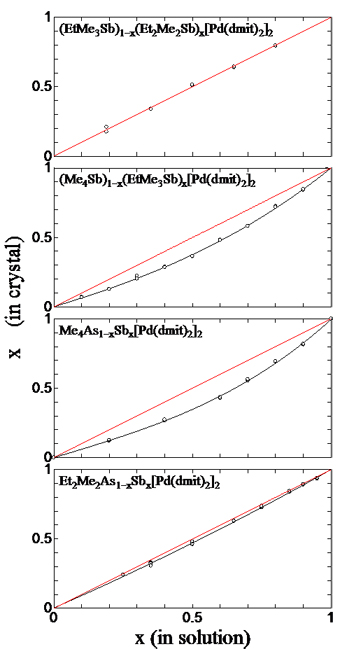 Figure 2: Mole fraction in crystal (x) as a function of that in reaction solution for each mixed crystals |
(2) High pressure electrical properties of a single component molecular crystal [Ni(ddt)2]
Assign: Cui, Tsumuraya, Miyazaki, Kato
Because the molecular system has soft lattice, an application of high pressure to molecular crystals is a very effective way to discover new single component molecular metals. Single crystals of [Ni(ddt)2] were freshly prepared from [(n-C4H9)4N]2[Ni(ddt)2] by I2 oxidation, In crystal, the [Ni(ddt)2] molecules are strongly dimerized, the Ni…Ni distance was 3.0798 Å. (See Figure) Because of strong dimerization, the HOMO-LUMO band inversion would occur. Due to the band widening by pressure, these two bands will overlap each other to form a new type of metallic state under high pressure. We measured the high pressure electrical resistivity up to 15GPa by using a diamond anvil cell. The room temperature resistivity abruptly decreased with increase in pressure. When pressure reached 11GPa, a metallic state was observed down to 25 K. (ddt= 1,4-dithiin-2,3-dithiolato)

Figure: Molecular and crystal structure of [Ni(ddt)2]
(3) Multiple band molecular conductors based on Pt(dmit)2 complex
Assign: Nomura, Tsumuraya, Cui, Abdel Jawad, Guilhem, Oshima, Kato
A series of anion radical salts derived from Pd(dmit)2 complex are Mott insulators at ambient pressure and show metallic/superconducting properties under pressure. Since the energy gap formed by a dimerization of the metal complex (dimerization gap = 2|tH| or 2|tL|) is larger than the HOMO-LUMO gap of the monomer complex ( E), the bonding LUMO pair is located below the antibonding HOMO pair. The [Pd(dmit)2]2- dimer units form a two-dimensional (2D) triangular lattice where interplay of electron correlation and spin frustration operates. One can precisely control the electronic properties by applying physical stimuli and chemical modification (chemical pressure) of the molecule. In the R4Z[Pd(dmit)2]2 (R = Me, Et) salts with quaternary onium cations, chemical modifications of the R group systematically control the interdimer HOMO…HOMO transfer integrals and thus anisotropy of the triangular lattice, whereas these fundamental crystal structures are maintained. The cation modifications, however, do not significantly control the intradimer HOMO…HOMO transfer integral (tH). The modification of tH may be further possibility to precisely control the electronic property of a 2D dimer Mott system, because we can control the dimerization gap and degree of HOMO-LUMO band overlap. In the last fiscal year, we reported that the replacement of the Pd with Pt in the dimer complex effectively reduced the |tH| value. Furthermore, the tH value in the Pt(dmit)2 salt was largely modified by use of various tetramethylonium cations (Me4Z+; Z = N, P, As, Sb). In this work, we also prepared several Pt(dmit)2 salts with ethylated or fluorinated onium cations (Figure 2), and investigated their structures, physical properties, and band structures, comparing with those of the Me4Z+ salts.
A series of Pt(dmit)2 salts with EtMe3Z+ (Z = P, As, Sb), Et2Me2Z+ (Z = P, As) and (FCH2)Me3Z+ (Z = N, P) cations were obtained by electrochemical or aerial oxidations. A main product in the EtMe3P+ salt was a crystal with the space group P21/m, having two equivalent and parallel conducting layers. The other onium cation salts crystallized in the space group C2/c exhibiting β, γ or β' morphology (Figure 2), which includes two equivalent conducting layers with different stacking directions (solid crossing column structure). All the Pt(dmit)2 salts prepared in this work were isostructural with those of the corresponding Pd(dmit)2 salts.
The P21/m-EtMe3P+ salt showed an intradimer Pt-Pt bond of 3.156 Å, which is the shortest bond length of all the Pt(dmit)2 salts prepared in this work. In the β'-crystals, the Pt-Pt bond lengths were largely modified from 3.182 Å (Et2Me2P+ salt) to 3.308 Å (Me4P+ salt). The values of the intradimer transfer integral tH were also largely changed from 413 meV (Et2Me2P+ salt) to 359 meV (Me4P+ salt). On the other hand, the tH values of Pd(dmit)2 salts are slightly modified by cation effect (Figure 3). In the β'-Me4P+ or β'-Me4As+ salt, there is a relatively small dimerization gap, because use of a small cation provides reduction of the tH value. First-principles density-functional theory calculations revealed a multiple band character where HOMO-based and LUMO-based bands overlap in the vicinity of the Fermi level (Figure 1(a)). The Me4As+ and Me4P+ salts show quasi 1D open Fermi surface derived from the multiple band. This is because the 1D LUMO-based band is located around the Fermi level in these salts. On the other hand, other onium cation salts demonstrated 2D Fermi surface, because strong dimerizations in these salts do not show the multiple band character. We conclude that the choice of counter cation (chemical modification) controls the dimerization gap, degree of the HOMO-LUMO band overlap and dimensionality of Fermi surface.
The β'-EtMe3Z+ and β'-Et2Me2Z+ salts of Pt(dmit)2 salts showed metallic behavior in high temperature region under ambient pressure. These results are similar to those of the β'-Me4Z+ salts (Z = P, As, Sb) as shown in Figure 4. It is quite different than most Pd(dmit)2 salts demonstrate Mott-insulating behavior under ambient pressure. The Pt(dmit)2 salts underwent metal-insulator transitions in the temperature range of 150-220 K. Charge ordered states were observed in the low temperature region. Choice of the cation modified the phase transition temperature. In the low temperature region, the neutral dimer [Pt(dmit)2]20 and divalent dimer [Pt(dmit)2]22- are alternatively arranged with a checkerboard-type structure (Figure 5). All the Pt(dmit)2 salts became insulating under several kbars of hydrostatic pressure (Figure 4). These results explain that a pressure effect enhances degree of the dimerization giving a Mott-insulating state. A band structure of the β'-Me4P+ salt under pressure obtained by a first-principles calculation indicated that the enhanced dimerization gap induces the band separation into the individual HOMO and LUMO bands. In addition to the band separation, the Fermi surface of the β'-Me4P+ salt derived from the HOMO band becomes 2D under pressure (Figure 1(b)). This is because the 1D LUMO band is shifted apart from the Fermi level by the enhanced dimerization gap. We conclude that physical pressure also controls the dimerization gap, degree of the HOMO-LUMO band overlap as well as dimensionality of Fermi surface.
(dmit = 1,3- dithiol-2-thione-4,5-dithiolate)

Figure 1: (a) Band structure and Fermi surface of the β'-Me4P[Pt(dmit)2]2 salt and
(b) band structure and Fermi surface of the β'-Me4P[Pt(dmit)2]2 salt under pressure
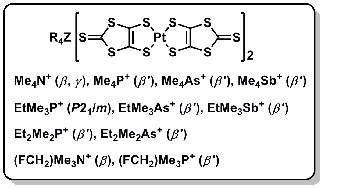 Figure 2: Pt(dmit)2 salts studied in this work (Crystal morphology or space group) |
 Figure 3: Cation effect on intradimer M-M distance and intradimer transfer integral (tH) |
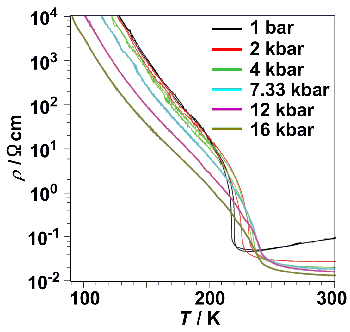 Figure 4:Temperature and pressure dependent electrical resistivity of the β'-Me4P[Pt(dmit)2]2 salt |
 Figure 5:Checkerboard-type molecular arrangement at charge ordered state (Red: neutral dimers, blue: divalent dimers) |
(4) Dielectric constant of Pd(dmit)2 salts
Assign: Abdel Jawad, Kato; N. Tajima
A systematic study of the dielectric constant in the β'-type Pd(dmit)2 salts shows anomalous behavior throughout this class of highly dimerized charge transfer salts. The anomaly is best described as a relaxor-like response of the dielectric constant implying the presence of both electrical dipoles and substantial amount of disorder. This anomaly was first reported in κ-(BEDT-TTF)2Cu2(CN)3, another dimer Mott insulator known for its highly frustrated lattice of dimer unit. We suspect that this behavior is common to most dimer-Mott insulator and that the origin of the dipole moment is the charge confined between the two large molecules of the dimer unit.
An analysis of the dielectric data (Figure) shows a clear relation between electronic correlation and the dipole-dipole interaction; also, geometrical frustration appears to weaken this interaction. Furthermore, the DC and AC conductivities are shown to be closely correlated and follow the same universal AC conductivity as disordered solids.
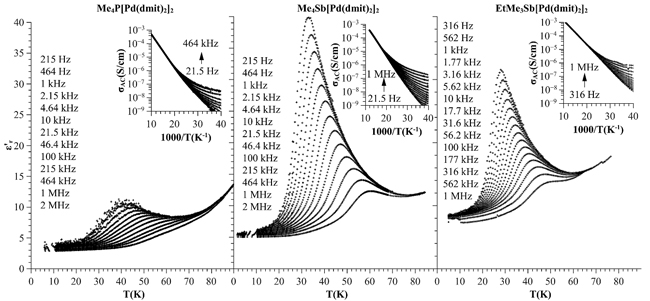
Figure: Frequency and temperature dependence of the dielectric constant and the AC conductivity (top left)
of Me4P[Pd(dmit)2]2, Me4Sb[Pd(dmit)2]2 and EtMe3Sb[Pd(dmit)2]2
(5) Critical exponents of the Mott transition in EtMe3P[Pd(dmit)2]2
Assign:Abdel Jawad, Kato, N. Tajima, Watanabe, Ishii
The Mott transition is thought to belong to the Ising universality class. This was proven to be true at high temperature from the values of the critical exponents (δ, β, γ)=(3,1/2,1) found by isothermal pressure sweeps measurements of the conductivity in Cr-doped V2O3. However, identical measurements of the Mott-transition in κ-(BEDT-TTF)2Cu[N(CN)2]Cl, found critical exponents ( δ, β, γ)=(2,1,1) which do not fit within the Ising universality class. Those unconventional values of the critical exponents are thought to arise from the low temperature of the critical exponents where quantum fluctuations are important. We have recently succeeded in measuring the isothermal pressure dependence of the conductivity in EtMe3P[Pd(dmit)2]2 another dimer-Mott insulator and found unconventional critical exponents (Figure). For instance, value is close to 7/4. Further work is under way to narrow down the values of β and γ.
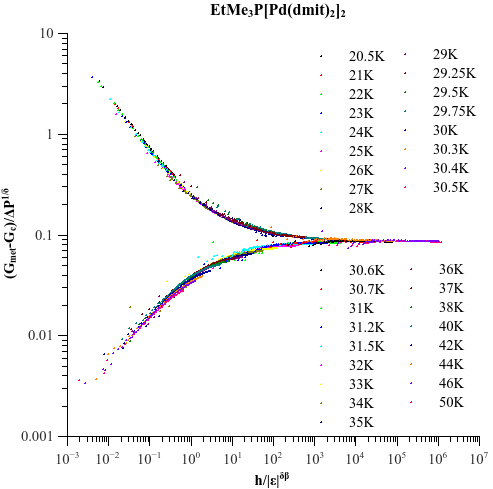
Figure: Scaling plot of the conductance in the metallic region of the phase diagram of EtMe3P[Pd(dmit)2]2. ΔP is the pressure difference to the first order line (T<Tc) or the crossover line (T>Tc). Δε is the temperature difference to the critical point temperature. Gc is the critical conductance of the metallic region for T<Tc.
(6) First-principles study on the electronic structure of (Cation)[Pd(dmit)2]2
Assign: Tsumuraya, Kato; Seo, Tsuchiizu, Miyazaki
Most of β'-Pd(dmit)2 salts are Mott insulators at ambient pressure. Electronic structure of β'-Pd(dmit)2 salts with various kinds of cations has been investigated on the basis of first-principles calculations based on the density functional theory (DFT). It was reported that anisotropy of the electronic structures are closely related to the structure of Pd(dmit)2 dimers by performing band structure calculations using both the tight-binding model with the extended Hückel method and the DFT method; crystal structures determined by experiments show that inter atomic distances of Pd(dmit)2 molecules and an anisotropy of the two-dimensional quasi triangular networks in terms of the Pd(dmit)2 dimers are slightly different depending of the counter cation.
In this fiscal year, we performed a tight-binding (TB) fit of the DFT bands and obtained the TB model using a single orbital of each dimer, with three interdimer transfer integrals, TB, tS, and tr, in the Pd(dmit)2 layer, as defined in Figure 1. We find systematic variation in the anisotropy of the transfer integrals along the three directions of the triangular lattice taking different values. As plotted in Figure 1, the transfer integral along the face-to-face stacking direction of Pd(dmit)2 dimers, tB, is always the largest. This implies a one-dimensional (1D) character as a first approximation. The 1D chains are connected by tS, and tr. Around the two salts showing the competing ground states (the EtMe3Sb salt shows the quantum spin liquid state and the Et2Me2Sb salt shows the charge order state), the other two transfer integrals become comparable Such a tendency indicates a possible relevance of effective 1/ 2-filled electronic models or Heisenberg models where 1D chains are coupled via two frustrated interactions on an anisotropic triangular lattice.
Furthermore, it was suggested that the bands at the Fermi level and the bands located around -0.4 eV mainly come from the antibonding pair of HOMOs and the bonding pair of the lowest unoccupied molecular orbitals (LUMOs) of the Pd(dmit)2 molecule, respectively. By analyzing the local density of states and Kohn-Sham orbitals of the solids, and the MOs of the isolated dimer (Figure 2), we revealed noticeable differences in charge distribution between the right and left dmit ligands of the Pd(dmit)2 unit. This implies that the HOMO of the Pd(dmit)2 monomer hybridizes with the LUMO of the other monomer within the dimer. This is possible since the HOMO-LUMO gap of the Pd(dmit)2 monomer is relatively small and the symmetry with respect to the left and right dmit ligands is broken upon dimer formation in the solids. This intramolecular degree of freedom may play important roles that clarify the various physical properties observed in the β'-Pd(dmit)2 salt series.
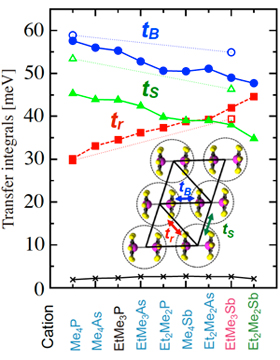 |
 |
| Figure 1(left): Cation dependence of interdimer transfer integrals, tB, tS, and tr and interlayer transfer integral shown by solid circles, solid triangles, and solid squares, and crosses, respectively. The corresponding open marks indicate the transfer integrals obtained using the low-temperature structures. Figure 2(right): (a) Local density of states (LDOS) of β'-Et2Me2Sb[Pd(dmit)2]2. Dashed curves indicate the LDOS from the left ligand, and solid curves, that from the right dmit ligand. A vertical dashed line represents the Fermi level. The LDOS of the left ligand includes partial DOS from C1-3, S3, S4, S7, S8, and S10, while that from the right includes from C4-6, S1, S2, S5, S6, and S9 atoms shown in (b). Contour plots of molecular orbitals for an isolated dimer, [Pd(dmit)2]2-, calculated using (c) the singly occupied molecular orbital (SOMO) and (d) HOMO within B3LYP. |
|
(7) Development of novel bi-layer Ni(dmit)2 anion radical salts
Assign: Kusamoto, Oshima, Kato; S. Yamashita, H. Yamamoto, N. Tajima
We have revealed that (Et-4BrT)[Ni(dmit)2]2 is a Bi-layer Mott system, which realizes co-existence of antiferromagnetic (AFM) and ferromagnetic (FM) short-range ordering layers below 30 K as well as large negative magnetoresistance (-75 % at 7 T) at 4 K under 1 GPa. This year, we developed new Ni(dmit)2 anion radical salts (Et-4IT)[Ni(dmit)2]2 and (Et-4ClT)2[Ni(dmit)2]5, (Figure1), in which Et-4IT and Et-4ClT contain I and Cl atoms respectively, in place of Br atom on Et-4BrT. The crystal and electronic structures, conductivity and magnetic properties of the salts were investigated.
(Et-4IT)[Ni(dmit)2]2 was isostructural with (Et-4BrT)[Ni(dmit)2]2 and formed a bi-layer structure. Band structure calculation and the conducting and magnetic measurements indicated that this salt is a bi-layer Mott system, where both of two crystallographically independent anion layers form Mott insulating states. The magnetic studies revealed a low temperature FM behavior that was weaker in this salt than in (Et-4BrT)[Ni(dmit)2]2. (Figure 2) We focused on the arrangement and spin polarization of the anion in the layer A (Figure 3), which is expected to exhibit the FM behavior. It was suggested that the unique low temperature magnetic properties of these bi-layer Mott salts originate from a competition between the FM interaction based on the spin polarization and the AFM interaction based on the intermolecular overlap integrals.
(Et-4ClT)2[Ni(dmit)2]5 formed a mono-layer structure, which was different from bi-layer structure of (Et-4BrT)[Ni(dmit)2]2. The halogen bonds between Clcation…Sanion as well as Scation…Sanion atomic contacts were detected in the crystal. The band insulating nature was confirmed by the band structure calculation and electric and magnetic measurements.
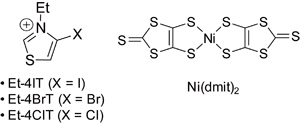 Figure 1: (Et-4XT)[Ni(dmit)2]2 |
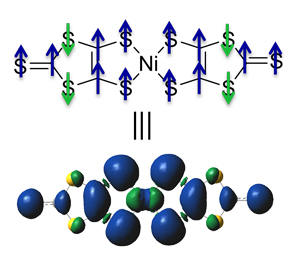 Figure 3: Spin density distribution of [Ni(dmit)2]- |
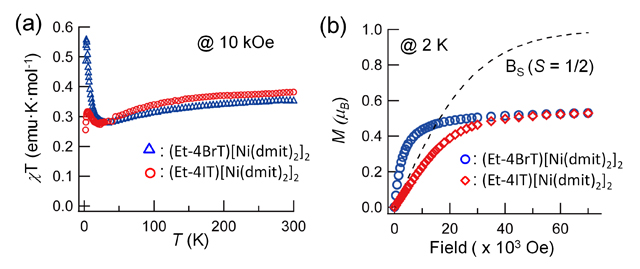 Figure 2: Temperature-dependent ΧT at 10 kOe (a) and magnetization curve at 2 K (b) of (Et-4XT)[Ni(dmit)2]2 (X = I, Br) |
|
(8) Anomalous Hall effect in (Me-3,5-DIP)[Ni(dmit)2]2
Assign: Kato; N. Tajima, A. Tajima, Kosaka, H. Yamamoto
Bi-layer electron system which consists of metallic layers with large Fermi surface and Mott-insulating layers with localized spins was realized in (Me-3,5-DIP)[Ni(dmit)2]2. In this work, we investigated Hall effect in this system. The purpose is to clarify the characteristic transport phenomena associated with the localized spins.
We succeeded in detecting the anomalous Hall effect originated from the localized spins. The temperature dependence of the Hall coefficient RH obeys curie-wise law. It is written as, RH=RH0+RA, where RHO is a normal Hall coefficient and RA is an anomalous Hall coefficient which depends on magnetic susceptibility.

Figure: Temperature dependence of the Hall coefficient.
(9) Development of novel molecular magnetic conductors with Ferrocene-TTF hybridized organic donors
Assign: Kusamoto, Kato
We have revealed that the redox behavior and electronic structure of Fc (Ferrocene)-TTF(tetrathiafulvalene) hybrid molecule FcS4TTF(R)2 depend on the substituent R (Figure 1). We performed single-crystal structure analyses and magnetic measurements of FcS4TTF(SMe)2, [FcS4TTF(SMe)2](F4TCNQ), which contains monocation radical of FcS4TTF(SMe)2, and [FcS4TTF(CF3)2](BF4)2-(solvent), which is a dication salt of FcS4TTF(CF3)2. We revealed that the TTF moiety is oxidized to form π-radical for the [FcS4TTF(SMe)2]+ cation, while both Fc and TTF moieties are 1e- oxidized to realize co-existence of d- and π-spin for the [FcS4TTF(CF3)2]2+ dication. Interestingly, the molecular structure of each molecule appreciably reflects the spin state (Figure 2).

Figure 1: Molecular structure and redox behavior of FcS4TTF(R)2.

Figure 2: Molecular structures and spin states of FcS4TTF(SMe)2(a), [FcS4TTF(SMe)2]+(b), [FcS4TTF(CF3)2]2+(c), in the crystals.
(1) Field-effects in κ-(BEDT-TTF)2Cu[N(CN)2]Cl near the Mott transition
Assign: Suda, Kato; H. Yamamoto
κ-(BEDT-TTF)2Cu[N(CN)2]Cl(κ-Cl) is a strongly-correlated molecular conductor and the competition between the electron-electron Coulomb repulsion and the kinetic energy is highlighted, resulting in the pressure-induced bandwidth-controlled Mott transition. Recently, we have demonstrated an electric field-induced Mott transition in a thin-single crystal of κ-Cl. We report here the electrostatic carrier doping (ESD) into κ-Cl near the band-width-controlled Mott transition. We fabricated a single crystal FET of κ-Cl with a plastic substrate. The combination of ESD and strain effects induced by bending the substrate enables co-regulation of "bandwidth" and "band-filling" in κ-Cl. The κ-Cl on the substrate exhibited a superconducting behavior due to the positive pressure from the substrate. The -Cl showed a superconductor-to-insulator transition by applying the strain-effects (effectively negative pressure). Successively, we tried ESD into the κ-Cl under the strain. Interestingly, we found the field-effects also in the mixed state occurred during the Mott transition (Figure). Remarkable device mobility, ca. 280 cm2/Vs was obtained in this region although the ON/OFF ratio was only 10 %. Furthermore, this field-effect was almost compressed by applying external magnetic field (7 T). This means that the superconducting fraction emerged by ESD into the insulating phase in the mixed state. This result suggests that the field-induced superconductivity will be possible by increasing the number of injected carriers.
(BEDT-TTF = bis(ethylenedithio)tetrathiafulvalene)
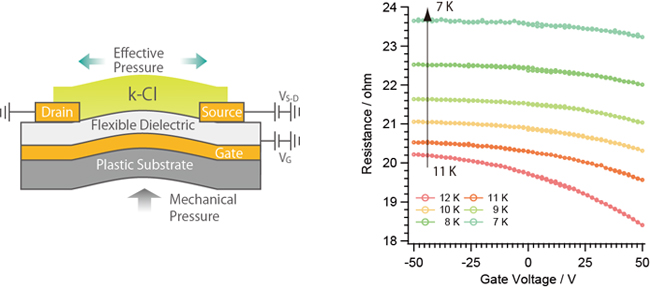
Figure:Schematic illustration for the FET device(left) and Field-effects
in κ-(BEDT-TTF)2Cu[N(CN)2]Cl near the Mott transition(right)
(2) Development of monolayer Mott FET utilizing self-assembly process
Assign: Suda, Kato; H. Yamamoto
Generally, charge carriers in a field-effect transistor are confined by the gate field as a thin accumulation layer at the semiconductor-gate dielectric interface. When we use a molecular monolayer as a channel layer, the layer thickness is comparable to that of the accumulation layer. Hence, the monolayer FET, if realized, will have great possibilities to improve device performances. Here, we have designed self-assembled monolayer transistor composed by (BEDT-TTF)(TCNQ) charge transfer complexes. (BEDT-TTF)(TCNQ) would be a good candidate for the monolayer FET, because this compound has Mott insulating phase near room temperature. The device was fabricated by immersion of Si++/SiO2 substrate into mixed solution of BEDT-TTF derivative and TCNQ (Figure left). The superior device performance (ON/OFF ratio > 101, mobility = 0.1 cm2/Vs) compared to the device with bulk-crystal was obtained (Figure right). At present stage, it is not clear whether this device works as Mott FET or not. We will investigate the Hall Effect to clear this point.
(BEDT-TTF = bis(ethylenedithio)tetrathiafulvalene)
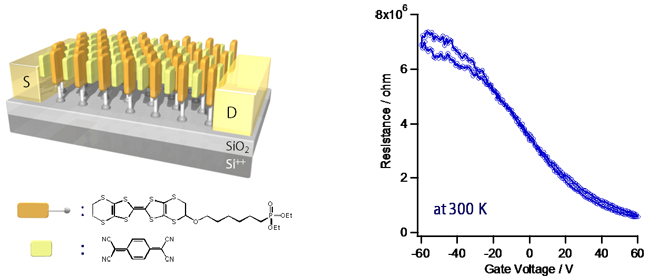
Figure:Schematic illustration for the Monolayer FET device(left) and Field-effects at 300 K (right)
Assign: Suda, Kato; N. Tajima, H. Yamamoto
We have discovered 2D massless Dirac Fermions system in organic conductor α-(BEDT-TTF)2I3 under high pressures.
This material with layered structure and tilted Dirac cones belongs to a broader category of 2D massless Dirac fermion system. However, the relativistic Landau level, which is the most important characteristic feature in the Dirac fermion system, has not directly been obtained yet. Both SdH oscillations and QHE have not been observed yet in this system until now, because the Fermi level is always located at the Dirac point. Moreover, the multilayered structure makes control of the Fermi level by the field-effect-transistor (FET) method much more difficult than the case of graphene. In order to clarify the primitive properties of our Dirac Fermion system, however, the detection of SdH oscillations and QHE are crucial. In this work, we made a breakthrough in the detection of SdH and QHE in the multilayered massless Dirac fermion system α-(BEDT-TTF)2I3 under high pressure. Our idea is the following.
According to our investigation of the Hall effect in α-(BEDT-TTF)2I3, the carrier density at low temperature is only 108 cm-2/sheet. Yet, the carriers are not localized but mobile with high mobilities. Thus, by fixing a crystal on a substrate weakly negatively charged by contact electrification, the effects of hole doping can be detected in the transport. Indeed, we succeeded in detecting SdH oscillations and QHE by fixing a crystal onto a polyethylene naphthalate (PEN) substrate.
(BEDT-TTF = bis(ethylenedithio)tetrathiafulvalene)

Figure: (a) SdH oscillations. (b) quantum Hall effect.
Assign: Takubo, Kato; H. Yamamoto, N. Tajima
We have studied photo-induced phase transition (PIPT) by focusing on photo-induced charge-order (CO) melting in BEDT-TTF salts. Previously, large photocurrent caused by nanosecond pulsed laser irradiation have been observed in α-(BEDT-TTF)2I3, (BEDT-TTF)3(ClO4)2, (BEDT-TTF)5Te2I6 and θ-(BEDT-TTF)2RbZn(CNS)4 (fast cooling). In addition, we have confirmed that large photocurrent was photo-induced insulator-to-metal transition (PIMT) by simultaneously conductance and transmittance measurement. This year, we demonstrated simultaneous conductance and transmittance measurement in (BEDT-TTF)3(ReO4)2 and (BEDT-TTF)3(ClO4)2 in order to investigate effect of electron-lattice interaction in PIMT. PIMT was observed in (BEDT-TTF)3(ReO4)2 where the CO state is associated with the lattice distortion. On the other hand, no PIMT was noted in (BEDT-TTF)3(ClO4)2 where the CO state is not accompanied by the lattice distortion (Fig. 1). This comparative study suggested that the lattice distortion plays a key role in the stabilization of the photo-induced phase. In addition, we observed nonlinear photocurrent with threshold of excitation light intensity (Fig. 2). This nonlinear photocurrent indicates that excitons are formed by electron-electron Coulomb interaction below the threshold and that high-density photoexcitation induces Coulomb screening, which results in exciton decoupling above the threshold.
Moreover, we have studied spectroscopy in teraheltz (THz) wave region and PIPT induced by THz wave irradiation in collaboration with Univ. of Tokyo. Specifically, we focused on superconducting transition in κ-(BEDT-TTF)2[Cu(CN)2]Br. We have prepared large thin crystals and have observed spectra for the THz region in the superconducting state. As a result, transmittance decreased as temperature decreased, whici reflects metallic DC conductivity. Superconducting gap was not observed in transmittance.
(BEDT-TTF = bis(ethylenedithio)tetrathiafulvalene)

Figure 2 (right): Correlation between excitation light intensity and photocurrent immediately after light irradiation in (BEDT-TTF)3(ClO4)2 at 10 K.
Assign: Oshima, Cui, Kato
The π-d molecular conductors show interesting physical phenomena, such as field-induced superconductivity or giant magneto-resistance, due to its non-negligible π-d interaction. The aim of this study is to control such interesting phenomena by flipping the local d spins or disturbing itinerant π-electrons by the use of electron spin resonance (ESR). Here, we have focused on the λ-(BETS)2FexGa1-xCl4 system which shows field-induced superconductivity (FISC) at high magnetic fields, and have studied whether the FISC state can be controlled by ESR transitions, which correspond to the spin-flips of d-electrons. Previously, simultaneous ESR and transport measurements were performed on λ-(BETS)2FexGa1-xCl4 (x=0.5 and 0.6), and we have observed a change in the resistance due to the ESR transitions since the resistance anomaly occurs at the same field position of the resonance field. To see the reproducibility of this above-mentioned behavior, we have also tried the x=0.34 mixed compound. Moreover, we have checked the power dependence of the irradiated millimeter wave as shown in Figure(b). The resistance change due to the breakdown of the FISC shows a linear relation with the attenuation of the irradiated millimeter wave. Such power dependence is the evidence that the breakdown of FISC is not due to the heat effect but due to the spin-flip of d-spins. Due to the skindepth and weak power of the millimeter-wave irradiation, the resistance change by ESR is very limited since only the FISC state at the surface is destroyed.
(BETS= bis(ethylenedithio)tetraselenafulvalene)

(b) The power dependence of the irradiated millimeter wave for 270 GHz at 3.6K. The attenuation diagram of the resistance change, due to the partial breakdown of the FISC, shows linearity.
Assign: Otaki
5-Bromo-9-hydroxyphenalenone (BHP; Figure 1), which has O-H…O type intramolecular hydrogen bond, belongs to zero-dimensional hydrogen-bonded system. The transition of the hydrogen atom in the intramolecular hydrogen bond inverts the transverse component (along the direction of O…O) of the dipole moment. This material exhibits a paraelectric-antiferroelectric phase transition in the D-compound around 38K, while the H-compound exhibits no phase transition. In the previous study, we have shown that the induction effect of the molecular dipole moment due to C-H…O type intermolecular hydrogen bond and π-π interaction depends on the relative configurations of hydrogen atom by using the Fragment Molecular Orbital (FMO) method. Furthermore, we have developed a new Monte Carlo method with FMO-derived dipole corrections as the induction effect and shown that the induction effect notably affects the phase transition temperature in the D-compound.
In this year, we have extended our Monte Carlo method to quantum Monte Carlo (QMC) method in order to describe the quantum nature of the hydrogen atom by introducing the tunneling effect. Figure 2 shows a phase diagram obtained by performing the QMC simulations with changing the proton concentration ratio (xH) in the crystal, which is compared with those of the experiment and mean field theory (MFT). Our results show similar curvature to the experimental results in the phase diagram; this indicates that our method adequately describes the balance between the tunneling and ordering of hydrogen (or deuterium) atom.
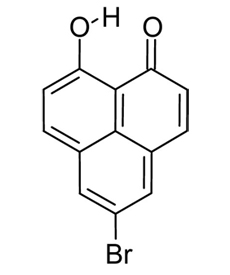 Figure 1: 5-Bromo-9-hydroxyphenalenone |
 Figure 2: Phase diagram of BHP. The horizontal axis corresponds to the phase transition temperature and the vertical axis corresponds to the proton concentration ratio (H:D = xH:1 - xH). Black solid line: Experimental result, QMC: Quantum Monte Carlo simulation, MFT: Mean field theory |












